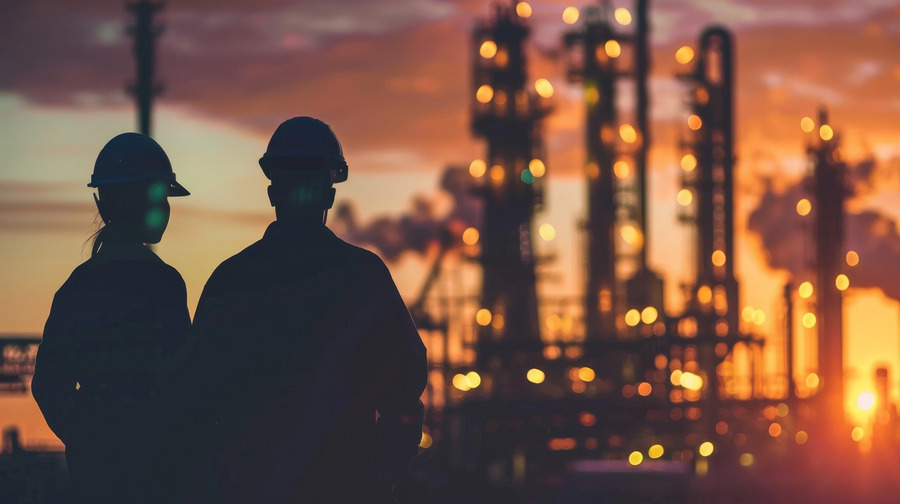A Combined Cycle Power Plant is a modern type of thermal power plant that uses two cycles instead of one to generate electricity.
-
It combines the Brayton Cycle (gas turbine) and the Rankine Cycle (steam turbine).
-
It uses natural gas as fuel, which is cleaner than coal.
-
It generates more electricity from the same amount of fuel by reusing waste heat.
So, it’s still a thermal plant (it uses heat to make electricity), but it’s a smarter, more efficient version.
How Does a Combined Cycle Power Plant Work?
Here’s how it works, step-by-step:
Gas Turbine (Brayton Cycle)
-
Natural gas is burned in a combustion chamber.
-
This creates very hot gases.
-
The hot gases spin a gas turbine, which turns a generator and produces electricity.
This is the first part of the energy.
Heat Recovery Steam Generator (HRSG)
-
The hot gases leaving the gas turbine still have a lot of heat.
-
Instead of wasting it, the plant passes this exhaust through a Heat Recovery Steam Generator (HRSG).
-
The HRSG uses this heat to boil water into steam.
No extra fuel is burned here — it’s recycled heat!
Steam Turbine (Rankine Cycle)
-
The steam from the HRSG spins a steam turbine.
-
This turbine also drives a generator, producing more electricity.
This is the second part of the energy.
Cooling and Recycling
-
After spinning the steam turbine, the steam is cooled back into water.
-
The water is sent back to the HRSG to repeat the cycle.
Combined Cycle vs Traditional Thermal Plants
| Feature | Traditional Thermal Plant | Combined Cycle Power Plant |
|---|---|---|
| Type of Turbine | Only steam turbine | Gas + steam turbines |
| Efficiency | 30–40% | 55–62% |
| Fuel Used | Coal, oil, or gas | Mostly natural gas |
| Waste Heat | Lost to environment | Reused to make steam |
| Emissions | Higher CO₂ & pollutants | Lower emissions |
| Water Use | High | Lower (with air-cooled systems) |
Combined cycle plants are like an improved version of traditional thermal plants — they make more electricity using the same or even less fuel.
Why Are Combined Cycle Plants More Efficient?
Traditional Thermal Plants:
-
Burn fuel → make steam → turn turbine → electricity.
-
But more than half the heat is lost after the steam cycle.
Combined Cycle Plants:
-
Burn fuel → gas turbine → electricity.
-
Then reuse leftover heat → make steam → more electricity.
This “second use of heat” is the secret behind the higher efficiency.
It’s like using hot water twice
How Much Energy Can They Save?
Let’s say you burn natural gas that has 100 units of energy.
-
A traditional thermal plant may only turn 35 units into electricity. The rest is lost.
-
A combined cycle plant can turn 55–60 units into electricity. That’s nearly double the output.
This means:
-
Less fuel needed
-
Less pollution
-
Lower energy costs
Environmental Benefits of Combined Cycle Plants
Combined cycle plants are not only efficient, they’re also cleaner than traditional coal-based thermal plants.
Lower CO₂ Emissions
-
Natural gas produces about 50% less CO₂ than coal per unit of electricity.
Less Air Pollution
-
They emit less SO₂, NOx, and particulate matter, which cause smog and respiratory problems.
Smaller Carbon Footprint
-
Since they use less fuel, their overall carbon footprint is lower.
Flexible Operation
-
Combined cycle plants can start up and shut down quickly, making them good partners for renewable energy sources like solar and wind.
Main Parts of a Combined Cycle Power Plant
Let’s list the key equipment:
| Component | Description |
|---|---|
| Combustion Chamber | Where natural gas is burned |
| Gas Turbine | Spins using hot gases from combustion |
| Generator | Converts mechanical energy to electricity |
| HRSG (Heat Recovery Steam Generator) | Captures leftover heat to make steam |
| Steam Turbine | Spins from steam and generates extra electricity |
| Condenser | Cools steam back into water |
| Cooling System | Helps recycle water or air cool the plant |
The Future of Thermal Power: Combined + Clean
As the world moves toward cleaner energy, combined cycle technology is leading the way in modern thermal power generation.
New Developments:
-
Advanced gas turbines with higher temperatures and better materials.
-
Carbon capture technology to trap CO₂ before it escapes into the air.
-
Hybrid systems that combine gas turbines with solar thermal or hydrogen fuel.
Eventually, combined cycle plants could even run on green hydrogen instead of fossil fuels!
Conclusion
The Combined Cycle Power Plant is one of the most important steps in improving how we make electricity. It builds upon the basic idea of a thermal power plant but takes it to the next level with better efficiency, cleaner fuel, and smarter heat use.
It’s like a turbocharged version of a regular power plant — making more power with less fuel and pollution. That’s a win for both energy and the environment.
As technology advances, we at AVR Energies move toward cleaner energy, combined cycle power plants will play a key role in building a sustainable future.

